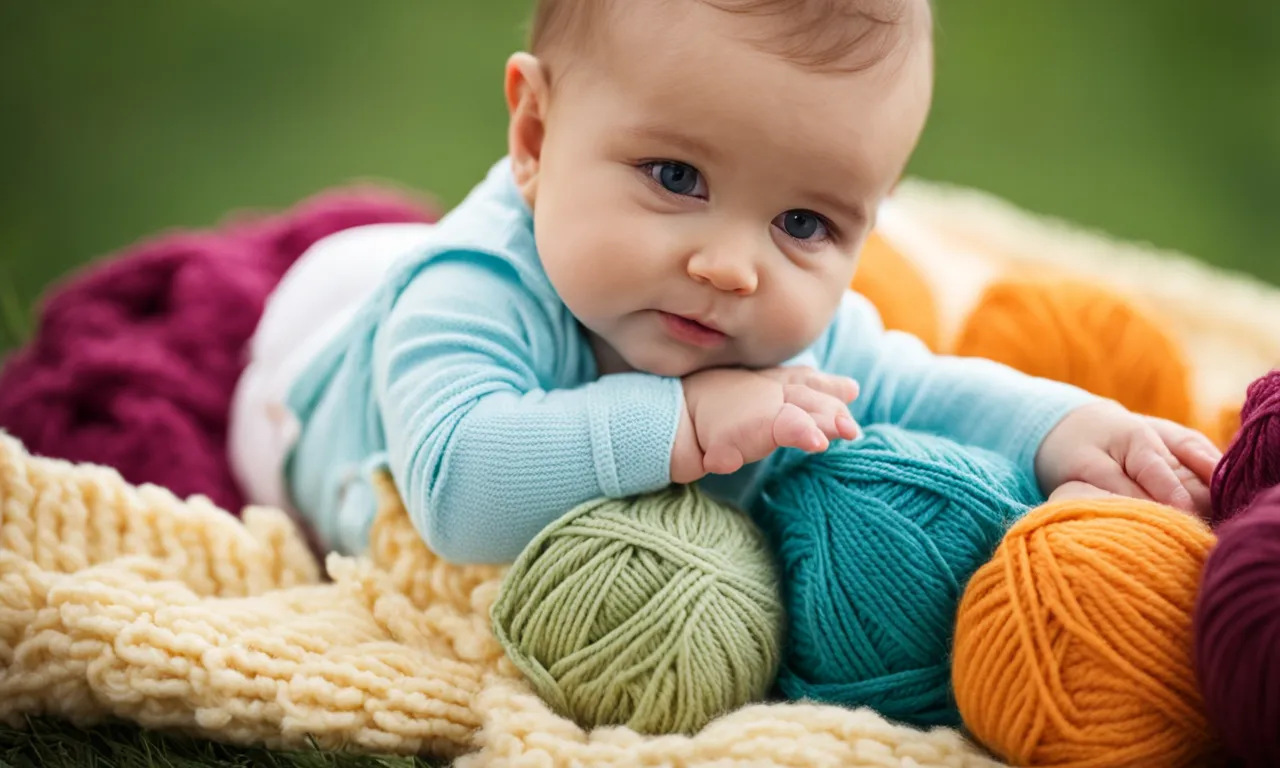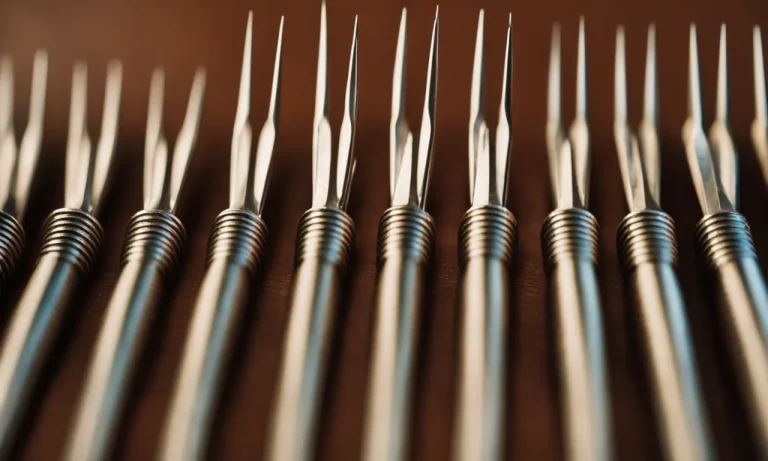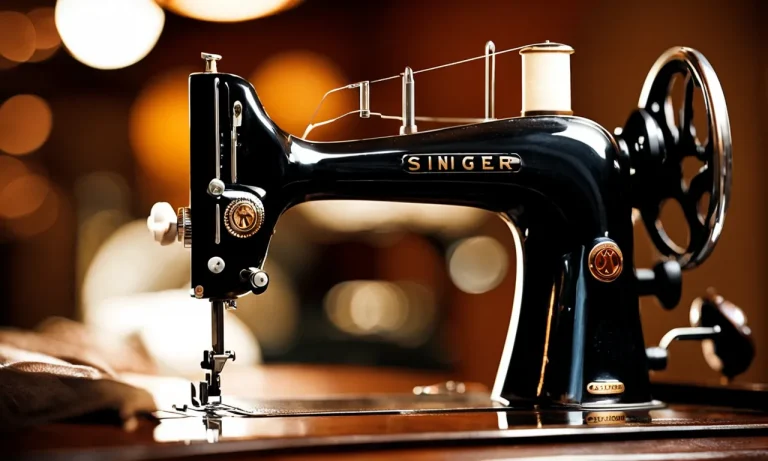Is Acrylic Yarn Safe For Babies?
Crocheting and knitting baby clothes and blankets is a rewarding hobby for many expecting parents. The wide array of available yarns can make choosing the right one confusing. If you want to know whether acrylic yarn is a safe option for baby items, you’ve come to the right place.
If you’re short on time, here’s a quick answer to your question: Acrylic yarn can be a good option for babies when used properly. Look for yarns that are soft, pill-resistant, and free of harmful chemicals.
What Is Acrylic Yarn?
Acrylic yarn is a type of synthetic yarn that is commonly used in knitting and crocheting projects. It is made from a polymer called polyacrylonitrile, which is derived from coal, air, water, petroleum, and limestone.
Acrylic yarn is known for its softness, durability, and affordability, making it a popular choice among crafters.
Made from Polyacrylonitrile
Polyacrylonitrile is a synthetic fiber that is produced through a chemical process called polymerization. It is a versatile material that can be used to create a wide range of products, including textiles, plastics, and carbon fibers.
In the case of acrylic yarn, polyacrylonitrile is spun into fibers and then processed into yarn.
One of the advantages of using polyacrylonitrile to make acrylic yarn is its ability to mimic the characteristics of natural fibers such as wool. Acrylic yarn can be made to look and feel like wool, but it is generally less expensive and easier to care for.
This makes it a popular choice for those who want the look and feel of wool without the cost or maintenance.
Properties of Acrylic Yarn
Acrylic yarn has several properties that make it suitable for various applications. Firstly, it is known for its softness and comfort. The fibers of acrylic yarn are smooth and lightweight, making it pleasant to work with and wear.
Additionally, acrylic yarn is known for its durability and resistance to fading, stretching, and shrinking. This makes it ideal for items that require frequent washing or exposure to sunlight.
Another advantage of acrylic yarn is its versatility. It can be easily dyed in a wide range of colors, allowing crafters to create vibrant and colorful projects. Acrylic yarn also has good moisture-wicking properties, which means it can keep the wearer dry and comfortable even in humid conditions.
Additionally, acrylic yarn is hypoallergenic, making it safe for those with sensitive skin or allergies.
Benefits of Acrylic Yarn for Babies
Affordable
One of the major benefits of acrylic yarn for babies is its affordability. Acrylic yarn is often much more budget-friendly compared to other types of yarn, making it a great choice for parents who want to create handmade items for their little ones without breaking the bank.
This means that you can crochet or knit beautiful baby blankets, hats, and clothing without spending a fortune. So, if you’re looking for a cost-effective option, acrylic yarn is definitely worth considering.
Machine Washable and Dryable
Another advantage of using acrylic yarn for baby items is its machine washable and dryable nature. As any parent knows, baby items can get dirty quickly, and the ability to throw them in the washing machine and dryer can be a real time-saver.
Acrylic yarn is known for its easy-care properties, allowing you to keep your baby’s hand-knit or crocheted items fresh and clean with minimal effort. This convenience is especially important for busy parents who don’t have the time or energy for handwashing and air-drying delicate materials.
Hypoallergenic
Acrylic yarn is often considered hypoallergenic, which means it is less likely to cause allergies or irritate sensitive skin. This makes it a safe and suitable option for babies who may have allergies or skin sensitivities.
Additionally, acrylic yarn is free from common allergens such as wool or animal fibers, making it a great choice for families who prefer to avoid these materials. However, it’s always a good idea to check your baby’s reaction to any new material, as individual sensitivities can vary.
Durable and Pill-Resistant
When it comes to baby items, durability is key. Babies can be quite rough on their clothing and accessories, so it’s important to choose yarn that can withstand their active lifestyle. Acrylic yarn is known for its durability and resistance to pilling, which is the formation of small balls of fiber on the surface of fabric.
This means that baby items made with acrylic yarn are less likely to look worn out or fuzzy after multiple uses and washes. With acrylic yarn, you can create long-lasting pieces that will remain in great condition even after lots of playtime and adventures.
Potential Downsides of Acrylic Yarn
Can Be Less Breathable
One potential downside of acrylic yarn is that it can be less breathable compared to natural fibers such as cotton or wool. Acrylic yarn is made from synthetic materials, which means it does not have the same ability to wick away moisture or regulate temperature as natural fibers do.
This can be a concern, especially for babies who have sensitive skin and are more prone to overheating. It is important to consider the climate and the intended use of the baby’s clothing or blankets when choosing yarn.
Not as Soft as Natural Fibers
Another aspect to consider is that acrylic yarn may not be as soft as natural fibers. While there are variations in the softness of acrylic yarn, it generally does not have the same luxurious feel as materials like cashmere or merino wool.
However, there are softer acrylic yarn options available in the market, so it is important to read product descriptions and reviews to find the best option.
Chemical Processing Concerns
One concern with acrylic yarn is the chemical processing involved in its production. Acrylic yarn is derived from petroleum-based products and goes through various chemical processes to achieve its final form.
Some individuals may be sensitive or allergic to the chemicals used, so it is essential to consider this factor when selecting yarn for baby items. It is always a good idea to look for yarn that is labeled as hypoallergenic or suitable for sensitive skin.
While there are potential downsides to using acrylic yarn for babies, it is important to note that it is still widely used and considered safe by many parents and experts. It is often chosen for its affordability, durability, and wide range of vibrant colors.
Ultimately, the decision to use acrylic yarn for baby items comes down to personal preference and individual considerations for the baby’s comfort and safety.
How to Choose a Safe Acrylic Yarn
When it comes to selecting acrylic yarn for your baby projects, safety should be a top priority. While acrylic yarn is generally considered safe for babies, there are a few factors to consider to ensure you are choosing a safe option. Here are some tips to help you make an informed decision:
Opt for Soft, Plush Yarns
When choosing an acrylic yarn for your little one, it’s important to prioritize softness. Look for yarns that are known for their plush texture and gentle feel against the skin. These types of yarns will be more comfortable for your baby and less likely to cause any irritation or discomfort.
Additionally, softer yarns are usually easier to work with and will result in a smoother finished product.
Avoid Excess Shedding
Another factor to consider when selecting acrylic yarn for your baby is shedding. Some acrylic yarns have a tendency to shed, which can be a choking hazard for babies who tend to put everything in their mouths. To avoid this, look for yarns that are specifically marketed as low-shed or non-shedding.
These yarns have been designed to minimize shedding, making them a safer option for your little one.
Check for Chemical Certifications
It’s also important to ensure that the acrylic yarn you choose for your baby is free from harmful chemicals. Look for yarns that have been certified as safe by reputable organizations. These certifications guarantee that the yarn has undergone rigorous testing to ensure it meets safety standards.
Additionally, opt for yarns that are labeled as hypoallergenic and free from any potentially harmful substances.
By following these guidelines, you can confidently choose a safe acrylic yarn for your baby projects. Remember to prioritize softness, avoid excessive shedding, and check for chemical certifications to ensure you are making the best choice for your little one.
Acrylic Yarn Safety Tips
Wash Before Use
When using acrylic yarn for your baby projects, it is important to wash the yarn before use. This will help remove any chemicals or residues that may be present from the manufacturing process. Washing the yarn will also help soften it, making it more comfortable for your baby’s delicate skin.
You can simply wash the yarn by hand using a mild detergent and warm water.
Don’t Use for Clothing Worn Directly on Skin
While acrylic yarn is generally safe for babies, it is recommended to avoid using it for clothing that will be worn directly on their skin. Acrylic yarn can sometimes cause irritation or discomfort for individuals with sensitive skin.
Instead, opt for natural fibers such as cotton or bamboo for baby clothing. These fibers are softer and more breathable, making them ideal for direct skin contact.
Use Other Fibers for Extra Softness
If you want to add extra softness to your baby projects, consider using other fibers in addition to or instead of acrylic yarn. There are many baby-friendly yarn options available, such as merino wool or alpaca, which are known for their incredible softness.
These fibers provide a luxurious feel and are gentle on your baby’s skin. Just keep in mind that these fibers may require special care when washing, so be sure to check the label for instructions.
For more information on baby yarn safety, you can visit the BabyCenter website. They provide helpful tips and advice on choosing the best yarn for your baby projects.
Conclusion
Acrylic yarn can be a budget-friendly option for knitting and crocheting baby items. Look for soft, pill-resistant yarns and wash items before use. Combining acrylic with natural fibers like cotton or wool can optimize softness and breathability.
While acrylic has some safety concerns, choosing quality yarns and using care when crafting will allow you to make cute, comfy items babies will love.







